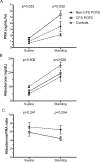Neurohumoral and haemodynamic profile in postural tachycardia and chronic fatigue syndromes
- PMID: 21906029
- PMCID: PMC3203411
- DOI: 10.1042/CS20110200
Neurohumoral and haemodynamic profile in postural tachycardia and chronic fatigue syndromes
Abstract
Several studies recognized an overlap between CFS (chronic fatigue syndrome) and POTS (postural tachycardia syndrome). We compared the autonomic and neurohormonal phenotype of POTS patients with CFS (CFS-POTS) to those without CFS (non-CFS-POTS), to determine whether CFS-POTS represents a unique clinical entity with a distinct pathophysiology. We recruited 58 patients with POTS, of which 47 were eligible to participate. A total of 93% of them reported severe fatigue [CIS (Checklist of Individual Strength), fatigue subscale >36], and 64% (n=30) fulfilled criteria for CFS (CFS-POTS). The prevalence of CFS symptoms (Centers for Disease Control and Prevention criteria) was greater in the CFS-POTS group, but the pattern of symptoms was similar in both groups. Physical functioning was low in both groups (RAND-36 Health Survey, 40±4 compared with 33±3; P=0.153), despite more severe fatigue in CFS-POTS patients (CIS fatigue subscale 51±1 compared with 43±3; P=0.016). CFS-POTS patients had greater orthostatic tachycardia than the non-CFS-POTS group (51±3 compared with 40±4 beats/min; P=0.030), greater low-frequency variability of BP (blood pressure; 6.3±0.7 compared with 4.8±1.0 mmHg2; P=0.019), greater BP recovery from early to late phase II of the Valsalva manoeuvre (18±3 compared with 11±2 mmHg; P=0.041) and a higher supine (1.5±0.2 compared with 1.0±0.3 ng/ml per·h; P=0.033) and upright (5.4±0.6 compared with 3.5±0.8 ng/ml per h; P=0.032) PRA (plasma renin activity). In conclusion, fatigue and CFS-defining symptoms are common in POTS patients. The majority of them met criteria for CFS. CFS-POTS patients have higher markers of sympathetic activation, but are part of the spectrum of POTS. Targeting this sympathetic activation should be considered in the treatment of these patients.
Figures


References
-
- Fukuda K., Straus S. E., Hickie I., Sharpe M. C., Dobbins J. G., Komaroff A. The chronic fatigue syndrome: a comprehensive approach to its definition and study. International Chronic Fatigue Syndrome Study Group. Ann. Intern. Med. 1994;121:953–959. - PubMed
-
- Jason L. A., Richman J. A., Rademaker A. W., Jordan K. M., Plioplys A. V., Taylor R. R., McCready W., Huang C. F., Plioplys S. A community-based study of chronic fatigue syndrome. Arch. Intern. Med. 1999;159:2129–2137. - PubMed
-
- Freeman R. The chronic fatigue syndrome is a disease of the autonomic nervous system. Sometimes. Clin. Auton. Res. 2002;12:231–233. - PubMed
-
- Wyller V. B., Saul J. P., Walløe L., Thaulow E. Sympathetic cardiovascular control during orthostatic stress and isometric exercise in adolescent chronic fatigue syndrome. Eur. J. Appl. Physiol. 2008;102:623–632. - PubMed
Publication types
MeSH terms
Substances
Grants and funding
LinkOut - more resources
Full Text Sources
Medical
Research Materials
Miscellaneous

